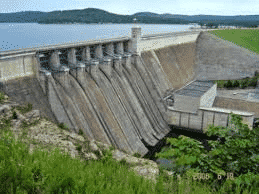When is a water control structure necessary?
Regardless of type, the major purpose of these water control structures is to control the flow of water. Today’s temporary water structures are used either to redirect the flow of heavy waters, to hold back flood waters, and also to providing a dry environment for working on a short-term project. Through Dewatering, Diversion and/or Damming, any accumulated water or moisture that may serve to impede the continuation of a project becomes a non-issue with the use of Dami-It Dams portable, temporary, dual inner-tube cofferdam.

Dewatering
De-watering (or un-watering) is the removal or drainage of ground or surface water, typically on a construction site. This method is often required before subsurface excavation for such things as foundations, shoring, cellar space, and repairs to existing water structures. Water control structures are an important part of this process, as they allow the work to proceed in a dry environment, conducive to construction.
Examples of Dewatering water-control situations include:
- Boat ramp repairs
- Bridge repairs
- Dredging
- Environmental remediation
- Shoreline restoration
- Wetland protection
Diversion
Diversion is the temporary (or possibly even permanent) re-routing of water either to a location or from a location where it’s no longer desired. It may be required to avert flooding, initiate a project or allow a project to proceed, as well as to control the location of a build-up of water.
Examples of Diversion water-control situations include:
- Bridge repairs
- Dredging
- Environmental remediation
- Flood control
- River crossings
- River flow
- Spillways
- Wetland protection
Damming
Damming is the process of creating a barrier that holds back water, oftentimes in cases of potentially strong force. The barrier may be needed to maintain water table levels, collect water for storage, or to prevent water from crossing established/safety thresholds.
Examples of Damming water-control situations include:
- Bridge repairs
- Canals
- Cold weather projects
- Dredging
- Environmental protection
- Environmental remediation
- Flood control
- Flood protection
- Shoreline protection
- Shoreline restoration
- Spillways
- Wetland protection
Which Water Structure Is Best for Water Control?
While determining the best water control solution is up to the individual, it’s important to note that most experts agree cofferdams are the best solution in their class due to the many advantages offered, particularly with Dam-It Dams’ cofferdams.
- Adaptability- They conform to virtually every type of landscape and weather condition to suit users needs.
- Affordability- They are a multi-use product, meaning they don’t have to be re-purchased and they use on-site water instead of tap water for filling.
- Availability- You can select from heights of 1′ to 12′, widths of 2′ to 23′ and unlimited lengths
- Durability- They are made of industrial strength geo-textile materials that can withstand tremendous water pressure are puncture-resistant. Workers can walk on them during installation and removal without fear of damage.
- Expandability- Multiple cofferdams can be connected as needed to form any length barrier required for the job.
- Low Labor Requirements- Unlike sandbags, you set up once (and do not need to change out due to saturation) until the purpose of the equipment is served.
- Portability- They go anywhere and are easy to transport and store. We can provide immediate and convenient delivery to your project site, as well as pick-up for rentals.
- Responsibility- Our cofferdams work with Mother Nature, not against her, and therefore create effective water barriers that leave minimal to no lasting footprint on the environment.
Our cofferdams are immediately available to accommodate virtually every project manager’s needs. Contact us today for more information and a free quote. Click here damitdams.com to go to our Home Page.

